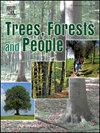Regeneration problem in Quercus floribunda Lindl. ex A. Camus. in its lower altitudinal range
IF 2.7
Q1 FORESTRY
引用次数: 0
Abstract
Himalaya are mainly dominated by broad-leaved Oak forests, which provides several ecosystem services and support local inhabitants for their livelihood. Quercus floribunda, not only provide crucial resources but also supports the survival systems of people living in the hills, though the regeneration of the species is declining over time. The present study was conducted in the Kumaun and Garhwal region of Uttarakhand to assess the composition and regeneration of Q. floribunda dominated forests in its narrow altitudinal range (1900–2600).. A total fourteen Q. floribunda dominated forests were selected at three elevations, High elevation sites (HES: 2600–2300 m), Mid elevation sites (MES: 2290–2150 m) and Low elevation sites (LES: 2100–1900 m). A total of 53 woody plant species including 14 trees and 39 shrubs were recorded from all the study sites. In the HES Q. floribunda had the highest total basal area ranging from 2551 m2/ha. The species appears to be regenerating profusely at MES and HES, however, low seedling density was a conspicuous feature at LES. The conversion of seedlings to saplings was upto 95% at MES. The maximum seed fall density in year 2023 was observed at the HES (31 seeds m-2). However, 2024 was a poor seed year; the seed fall was almost negligible in all the elevations. The poor regeneration of Q. floribunda at LES could be due to varied climatic factors and increasing anthropogenic pressure. It is clearly noticeable, that the regeneration status of Q. floribunda in the study area is “poor” and at risk in LES and systematic management plan for the conservation of Q. floribunda is essential at LES.
花栎的再生问题。A.加缪。在它的低海拔范围内
喜马拉雅地区以阔叶栎林为主,提供多种生态系统服务,支持当地居民的生计。尽管随着时间的推移,该物种的再生正在下降,但花栎不仅提供了重要的资源,而且还支持了居住在山区的人们的生存系统。本研究在北阿坎德邦的Kumaun和Garhwal地区,对其狭窄的海拔范围内(1900-2600)的白桦优势林的组成和更新进行了评价。在高海拔(HES: 2600 ~ 2300 m)、中海拔(MES: 2290 ~ 2150 m)和低海拔(LES: 2100 ~ 1900 m) 3个海拔点共选择了14个floribunda优势林,共记录到木本植物53种,其中乔木14种,灌木39种。总基底面积最高的是富里布达,为2551 m2/ha。在MES和HES条件下植株再生旺盛,而在LES条件下植株密度低。在MES中,幼苗转化为树苗的比例高达95%。2023年种子落密度最大(31粒m-2)。然而,2024年是一个糟糕的种子年;在所有海拔上,种子的落差几乎可以忽略不计。不同的气候因素和不断增加的人为压力可能导致了低海拔地区富绿柽柳再生能力差。结果表明,研究区红杉的更新状况为“差”和“危”,对红杉的保护制定系统的管理方案至关重要。
本文章由计算机程序翻译,如有差异,请以英文原文为准。
求助全文
约1分钟内获得全文
求助全文
来源期刊

Trees, Forests and People
Economics, Econometrics and Finance-Economics, Econometrics and Finance (miscellaneous)
CiteScore
4.30
自引率
7.40%
发文量
172
审稿时长
56 days
 求助内容:
求助内容: 应助结果提醒方式:
应助结果提醒方式:


